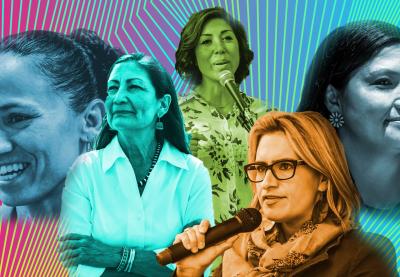One news story that kept coming up throughout the summer and fall of 2018 was about the role of women in the 2018 midterm elections. Predicting the “women’s wave” that would mark a “breakthrough moment” in our democracy, reports and articles often separated the “unprecedented number of women” on the ballot into demographic groups. They said that 2018 was the year of the Latina, the year black women are taking power, the year two Muslim women join Congress. “There’s never been a Native American Congresswoman,” The New York Times announced in the spring. “That could change in 2018.”
On the whole, this media narrative was a good thing. Women across the country were being recognized for their willingness to engage and lauded for their commitment to run. Instead of ignoring intersectional identities, mainstream media embraced them.
But the story these articles present is incomplete—and, given the history of Native women particularly, it’s our job as educators to flesh it out.
Granted, the United States Congress is a powerful body. But the language of “record numbers,” “groundbreaking,” and “historic” is flawed: These words ignore the long history of Native women in leadership roles.
You can push back against it by giving students a thoughtful foundation to help them understand how leaders who are women of color—and Native American women leaders, specifically—are presented in the media.
Because language and representation matter. And the profiles our students find of these women influence the ways they see other women in power. Here are a few steps you can take to ensure that your students have a sense of the broader story.
Start the conversation by directing students to the media narratives about Native American women.
Students might, for example, compare the way one woman is described in different stories. Business Insider introduces “Sharice Davids, an openly gay Native American lawyer,” and her opponent, “GOP incumbent Kevin Yoder.” Students can compare these descriptions to one another and to the introduction of Davids in Indian Country Today: “Sharice Davids, Ho Chunk, is running for Congress.” What does each story assume its readers will think is important? What does each story assume its readers will think is unusual?
Challenge students to research Native women and leadership expectations in Indigenous communities for an essay or presentation assignment.
If you live in a community with a clearly accessible and available Indigenous nation, contact the nation and invite their cultural director or leaders to speak with your class about the role of women leaders in their current governmental and social structure.
These secondary sources can help you and your students understand this subject better:
- Native Knowledge 360 provides a useful introduction to “Power, Authority and Governance” in Native communities.
- Martha McLeod includes a special section on Native women leaders in her essay “Keeping the Circle Strong: Learning About Native American Leadership.”
- In his report on Native American women and nonprofit leadership, Raymond Foxworth includes a passage on “Narratives of Native American Women and Leadership.”
- The TED Talk “Changing the Way We See Native Americans” by Matika Wilbur may be useful for students.
- So may the TED Talk “What It Means to be a Navajo Woman” by Jolyana Bitsu.
Learn about Native women leaders from their own words.
Students can round out their understanding by turning directly to the source and learning how Native women leaders themselves have described their experiences. Here are four to start with:
- LaDonna Harris. Nation: Comanche. Political and social activist, founder of Americans for Indian Opportunity. In her KNME-TV “New Mexico’s Makers” interview, students will find quotes like this one: “When I got [to Washington, D.C.] and saw that women who were in government couldn’t travel because it’s not acceptable to go unchaperoned...Can you imagine? A woman that was in government, they couldn’t climb the ladder, the federal ladder even, and I thought that was so grossly unfair. That’s really what motivated me to get into the women’s movement, because when you see discrimination in one form, you can’t accept it in another.”
- Wilma Mankiller. Nation: Cherokee. First woman elected Principal Chief of the Cherokee Nation. In her speech “Challenges Facing 21st Century Indigenous Peoples,” she says, “Cooperation has always been necessary for the survival of tribal people and even today, cooperation takes precedence over competition in more traditional communities. It’s really quite miraculous that a sense of sharing and reciprocity continues in our communities into the 21st century, given the staggering amount of adversity Indigenous people have faced.”
- Sharice Davids. Nation: Ho Chunk. Candidate for U.S. Congress. Students might check out her campaign announcement video or her interview with The Kansas City Star on Facebook Live, during which she explains, “My lived experience has taught me how to listen better, how to be as inclusive as possible when thinking about approaches to problem-solving and leadership.”
- Deb Haaland. Nation: Laguna Pueblo. Candidate for U.S. Congress. In a CNN interview, she says, “We need to have good relations with our community in order to be successful.” Students can also watch her campaign announcement video.
Finally, teach students to be skeptical when news outlets proclaim that “record numbers” of Native women in leadership positions is “historic” or “groundbreaking.”
Talking to high school students about Native women leaders is an ideal opportunity to introduce the way that the intersections of gender, race and power for Native women—and women of color more generally—are presented in mainstream media.
When they compare contemporary media representations to their research, students should find that the headlines don't tell the full story of Indigenous women's leadership. The focus on “firsts” neglects how common it is for Native women to be leaders within their nations and communities.
Indigenous women have traditionally held leadership positions in their nations and continue to do so today. What is “historic” and “groundbreaking” is white settler American culture finally starting to pay attention.
Morris teaches writing and Native American/Indigenous Rhetorics at Kutztown University of Pennsylvania.


0 COMMENTS